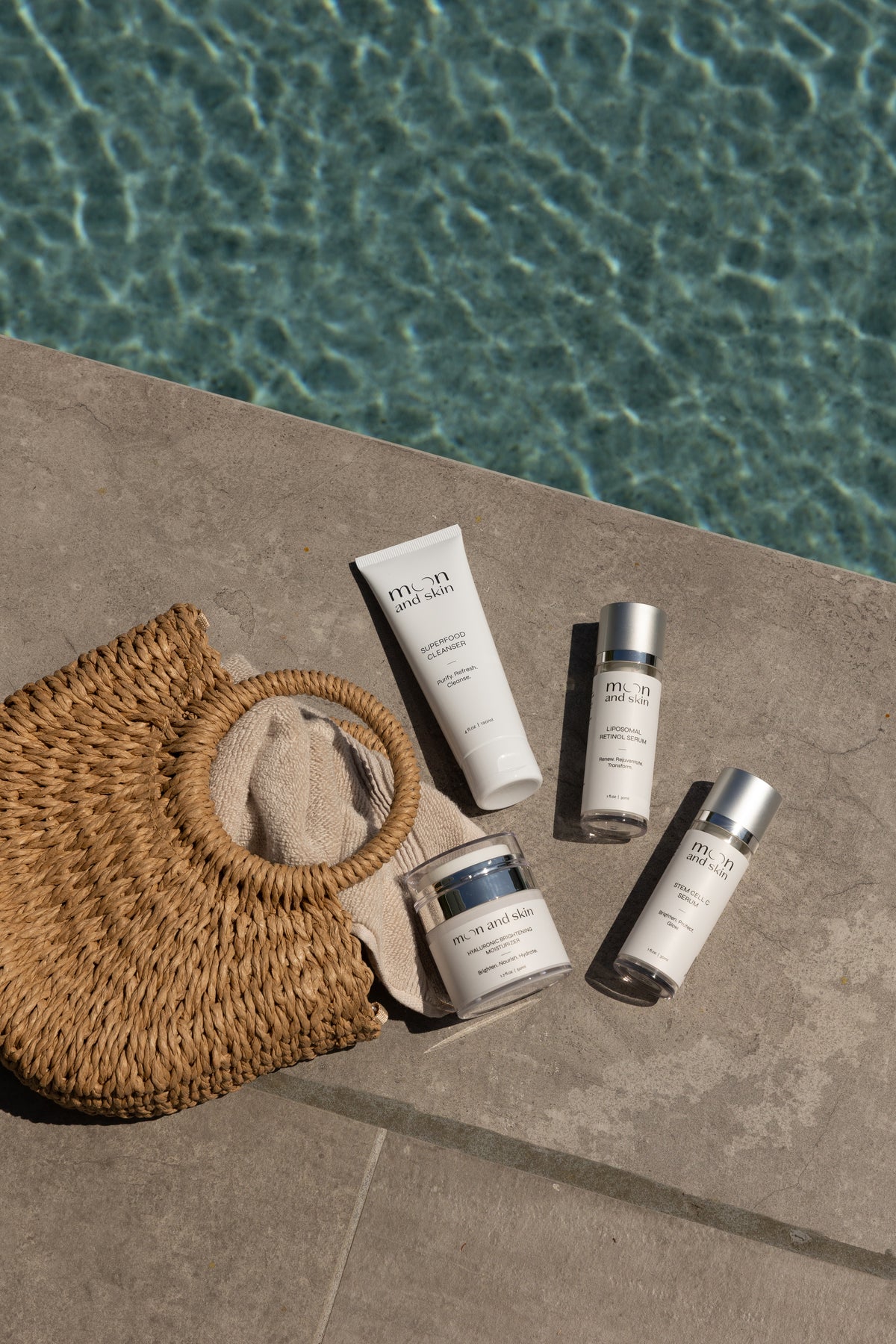सामग्री की सूची
- परिचय
- स्किनकेयर रूटीन के मूलभूत घटक
- स्किन टाइप के अनुसार अपनी रूटीन को अनुकूलित करना
- सामग्री चयन और आवेदन क्रम का महत्व
- स्थिरता बनाए रखने और अपनी त्वचा में बदलाव के अनुकूलन के लिए सुझाव
- निष्कर्ष
- अक्सर पूछे जाने वाले प्रश्न
परिचय
क्या आपने कभी अपने बाथरूम के शीशे के सामने खड़े होकर सही स्किनकेयर रूटीन के बारे में सोचा है, केवल उत्पादों की अपारता और विरोधाभासी सलाह से अभिभूत होकर? आप अकेले नहीं हैं। स्किनकेयर की दुनिया daunting लग सकती है, इससे भरी हुई है अनंत विकल्पों और जानकारी की प्रचुरता से। फिर भी, एक स्थायी और प्रभावी स्किनकेयर रूटीन बनाए रखना स्वस्थ, चमकदार त्वचा को बनाए रखने के लिए आवश्यक है।
आज, हम स्किनकेयर रेजीम के आवश्यकताओं में गहराई से उतरने वाले हैं, यह स्पष्ट करें कि आपको वास्तव में क्या विचार करना चाहिए। क्लीनजर्स से लेकर मॉइस्चराइजर्स तक, हम उन आवश्यक कदमों को स्पष्ट करेंगे जो आपकी अद्वितीय त्वचा टाइप और चिंता को पूरा करते हैं। इस गाइड के अंत तक, आपके पास एक स्पष्ट समझ होगी कि कैसे एक व्यक्तिगत स्किनकेयर रूटीन बनाना है जो Moon and Skin के हमारे मूल्यों के साथ मेल खाता है - व्यक्तिगतता, शिक्षा, और प्रकृति के साथ सामंजस्य पर ध्यान केंद्रित करना।
अपनी त्वचा और उसकी आवश्यकताओं को समझना चंद्रमा के चरणों के समान है - निरंतर विकसित होना और विभिन्न चरणों में अलग देखभाल की आवश्यकता होती है। Moon and Skin में, हम व्यक्तियों को उनकी त्वचा की यात्रा को गले लगाने के लिए प्रेरित करने में विश्वास करते हैं, स्वच्छ, विचारशील फॉर्मूलेशन के साथ जो हर व्यक्ति की अद्वितीयता को सम्मानित करते हैं।
इस लेख में, हम कवर करेंगे:
- स्किनकेयर रूटीन के मूलभूत घटक।
- आपकी त्वचा के प्रकार और चिंताओं के आधार पर अपनी रूटीन को कैसे अनुकूलित करें।
- सामग्री चयन और आवेदन क्रम का महत्व।
- स्थिरता बनाए रखने और अपनी त्वचा में बदलाव के अनुकूलन के लिए सुझाव।
- स्किनकेयर से संबंधित सामान्य प्रश्नों के उत्तर।
आइये इस ज्ञानवर्धक यात्रा पर चलते हैं यह जानने के लिए कि आपकी स्किनकेयर रूटीन में क्या होना चाहिए!
स्किनकेयर रूटीन के मूलभूत घटक
हर प्रभावी स्किनकेयर रूटीन आमतौर पर कुछ कोर घटकों के चारों ओर केंद्रित होती है। ये मौलिक कदम सुनिश्चित करते हैं कि आपकी त्वचा साफ, हाइड्रेटेड, सुरक्षित और पुनःजीवित रहती है।
1. सफाई
सफाई किसी भी स्किनकेयर रूटीन का पहला और शायद सबसे महत्वपूर्ण कदम है। यह दिन भर में जमा गंदगी, अतिरिक्त तेल, मेकअप, और अशुद्धियों को हटाती है। एक अच्छे क्लीनजर को आपकी त्वचा को साफ महसूस कराना चाहिए, लेकिन उसकी प्राकृतिक नमी छीननी नहीं चाहिए।
-
क्लीनजर के प्रकार: विभिन्न प्रकार के क्लीनर्ज उपलब्ध हैं, जिसमें जेल, क्रीम, तेल, और माइसेलर पानी शामिल हैं। प्रत्येक प्रकार विभिन्न त्वचा प्रकारों और चिंताओं के लिए होता है। उदाहरण के लिए, क्रीम क्लीनजर नरम और हाइड्रेटिंग होते हैं, जिससे यह सूखी त्वचा के लिए आदर्श होते हैं, जबकि जेल क्लीनजर तैलीय या मिश्रित त्वचा के लिए बेहतर हो सकते हैं।
-
आवृत्ति: आपकी त्वचा को दिन में दो बार साफ करने की सलाह दी जाती है - सुबह एक बार रात की तेलों को हटाने के लिए और रात में एक बार दिन के बिल्डअप को साफ करने के लिए।
2. समाप्ति
समाप्ति मृत त्वचा कोशिकाओं को हटाने में मदद करती है, कोशिका बदलाव को बढ़ावा देती है और ताजगी और चमकदार त्वचा को प्रकट करती है। यह कदम भौतिक समाप्तियों (स्क्रब) या रासायनिक समाप्तियों (असिड) का उपयोग करके किया जा सकता है।
- आवृत्ति: आपके त्वचा के प्रकार के आधार पर, समाप्ति सप्ताह में 1-3 बार की जा सकती है। ओवर-समाप्ति से जलन हो सकती है, इसलिए आपकी त्वचा की जरूरतों को सुनना महत्वपूर्ण है।
3. टोनिंग
टोनर्स आपकी त्वचा के pH स्तर को संतुलित करने में मदद करते हैं और एक अतिरिक्त हाइड्रेशन स्तर प्रदान कर सकते हैं। आधुनिक टोनर्स अक्सर फायदेमंद तत्वों को शामिल करते हैं जो आपकी स्किनकेयर रूटीन को और बढ़ा सकते हैं।
- टोनर का चुनाव: ऐसे फॉर्मूलेशन की तलाश करें जो बिना शराब के हों और हाइड्रेटिंग तत्व जैसे ग्लिसरीन या गुलाब जल शामिल करें।
4. उपचार उत्पाद
-
सीरम: ये उच्च सांद्रता वाले फॉर्मूलेशन होते हैं जो सक्रिय तत्वों को सीधे त्वचा में पहुँचाने के लिए डिज़ाइन किए जाते हैं। उदाहरण के लिए, विटामिन C सीरम कॉम्प्लेक्शन को उज्ज्वल कर सकता है, जबकि हायाल्यूरोनिक एसिड सीरम हाइड्रेशन प्रदान करते हैं।
-
स्पॉट ट्रीटमेंट्स: यदि आप विशेष मुद्दों जैसे ब्रेकआउट से जूझ रहे हैं, तो सलिसिलिक एसिड या बेंजॉयल पेरॉक्साइड शामिल स्पॉट ट्रीटमेंट्स प्रभावी हो सकते हैं।
5. मॉइस्चराइजिंग
मॉइस्चराइजर्स त्वचा को हाइड्रेट और सुरक्षित रखते हैं, जो इसके सीमा कार्य को बनाए रखने में मदद करते हैं। आपकी त्वचा के प्रकार के बावजूद, मॉइस्चराइजिंग महत्वपूर्ण है।
- मॉइस्चराइज़र का चयन: ऐसे मॉइस्चराइज़र का चयन करें जो आपकी त्वचा के प्रकार के अनुसार हो। हल्की जेल-आधारित मॉइस्चराइज़र तैलीय त्वचा के लिए अच्छी होती हैं, जबकि क्रीम-आधारित फॉर्मूले सूखी त्वचा के लिए बेहतर होते हैं।
6. सूर्य संरक्षण
यूवी नुकसान से अपनी त्वचा की सुरक्षा करना महत्वपूर्ण है, और सूरज संरक्षण किसी भी दिन के समय की स्किनकेयर रूटीन में एक अनिवार्य कदम है।
- सूर्य सुरक्षा का चुनाव: कम से कम SPF 30 के साथ एक व्यापक स्पेक्ट्रम सूर्य सुरक्षा की तलाश करें। इसे उदारता से लगाएं और बाहर समय बिताने पर हर दो घंटे में फिर से लगाएं।
स्किन टाइप के अनुसार अपनी रूटीन को अनुकूलित करना
अब जब हमने मूलभूत घटकों की स्थापना की है, तो आपकी विशेष त्वचा प्रकार और चिंताओं के आधार पर अपनी रूटीन को अनुकूलित करना आवश्यक है। यहां बताया गया है कि उपर्युक्त कदमों को कैसे समायोजित करें।
सामान्य त्वचा
यदि आपकी त्वचा सामान्य है, तो आप भाग्यशाली हैं! यह त्वचा प्रकार अच्छी तरह से संतुलित है और आमतौर पर इसमें बहुत कम समस्याएं होती हैं। एक साधारण रूटीन में शामिल हो सकते हैं:
- नरम क्लीनजर
- हल्का समाप्ति (सप्ताह में 1-2 बार)
- हाइड्रेटिंग टोनर
- हल्का मॉइस्चराइज़र
- व्यापक स्पेक्ट्रम सूर्य सुरक्षा
सूखी त्वचा
सूखी त्वचा वाले लोगों के लिए, ध्यान हाइड्रेशन और सीमा सुरक्षा पर होना चाहिए। निम्नलिखित समायोजन पर विचार करें:
- एक क्रीमी, हाइड्रेटिंग क्लीनजर का उपयोग करें।
- हल्के ढंग से समाप्ति करें, कठोर स्क्रब से बचें।
- एक समृद्ध मॉइस्चराइज़र का चयन करें जिसमें सेरामाइड्स और फैटी एसिड हों।
- हायाल्यूरोनिक एसिड के साथ एक हाइड्रेटिंग सीरम शामिल करें।
- दिनभर में सूरज सुरक्षा फिर से लगाएं।
तैलीय त्वचा
यदि आपकी त्वचा तैलीय रहती है, तो लक्ष्य अतिरिक्त तेल को प्रबंधित करना है जबकि हाइड्रेशन को बनाए रखना है:
- एक जेल-आधारित या फोमिंग क्लीनजर का उपयोग करें।
- जामनियों से भरे हुए भागों को रोकने के लिए नियमित रूप से समाप्ति करें।
- एक हल्का, ऑयल-फ्री मॉइस्चराइज़र चुनें।
- नियासिनामाइड या सलिसिलिक एसिड वाले सीरम को समर्पित करें।
- एक मैटीफाइंग सूर्य सुरक्षा चुनें।
मिश्रित त्वचा
मिश्रित त्वचा को थोड़ी अधिक ध्यान देने की आवश्यकता होती है, क्योंकि विभिन्न क्षेत्रों में विभिन्न आवश्यकताएं हो सकती हैं:
- एक नरम फोमिंग क्लीनजर का उपयोग करें।
- सप्ताह में 1-2 बार समाप्ति करें।
- टी-ज़ोन पर हल्का मॉइस्चराइज़र और सूखी क्षेत्रों पर समृद्ध क्रीम लगाएं।
- चेहरे के विभिन्न क्षेत्रों के लिए अलग-अलग सीरम का उपयोग करने पर विचार करें (मल्टी-मास्किंग)।
- एक व्यापक स्पेक्ट्रम सूर्य सुरक्षा चुनें जो आपकी त्वचा के प्रकार के अनुसार हो।
संवेदनशील त्वचा
संवेदनशील त्वचा को जलन से बचने के लिए नरम उत्पादों की आवश्यकता होती है:
- एक सुगंध-मुक्त, हाइड्रेटिंग क्लीनजर का उपयोग करें।
- संवेदनशीलता से बचने के लिए, हल्के रासायनिक समाप्तियों का चयन करें।
- चामोमाइल जैसी शांत करने वाली सामग्री के साथ शांत करने वाले टोनर्स का चयन करें।
- कम से कम सामग्री वाले समृद्ध मॉइस्चराइज़र लगाएं।
- जलन से बचाने के लिए खनिज-आधारित सूर्य सुरक्षा का चयन करें।
सामग्री चयन और आवेदन क्रम का महत्व
आपकी स्किनकेयर रूटीन की प्रभावशीलता काफी हद तक आपके उत्पादों में मौजूद सामग्री और उन्हें लगाने का क्रम निर्धारित करता है।
सामग्री चयन
सामग्री को समझना एक सफल स्किनकेयर रूटीन के लिए कुंजी है। यहां कुछ महत्वपूर्ण चीजें हैं जिन्हें ध्यान में रखना चाहिए:
- हायलुरोनिक एसिड: यह हाइड्रेशन के लिए उत्कृष्ट है क्योंकि यह अपने वजन का 1,000 गुना पानी धारण कर सकता है।
- विटामिन C: अपने उज्जवल गुणों के लिए जाना जाता है और ऑक्सीडेटिव तनाव से लड़ने की क्षमता।
- रेटिनॉल: एंटी-एजिंग के लिए एक शक्तिशाली तत्व, कोशिका बदलाव और कॉलाजेन उत्पादन को बढ़ावा देता है।
- नियासिनामाइड: सूजन को कम करने, रोम को छोटा करने, और समग्र त्वचा की बनावट में सुधार करने के लिए बढ़िया।
आवेदन क्रम
जब उत्पादों को लगाते हैं, तो "पतले से मोटे" नियम का पालन करना महत्वपूर्ण होता है। यह सुनिश्चित करता है कि हल्के उत्पाद त्वचा में प्रभावी रूप से समाहित हो जाएं इससे पहले कि भारी क्रीम नमी को सील कर दे। सामान्य क्रम इस प्रकार है:
- क्लीनजर
- टोनर
- उपचार (सीरम, तेल)
- मॉइस्चराइज़र
- सूर्य सुरक्षा (सुबह की रूटीन)
स्थिरता बनाए रखने और अपनी त्वचा में बदलाव के अनुकूलन के लिए सुझाव
स्किनकेयर रूटीन स्थापित करना सिर्फ शुरुआत है; स्थिरता दीर्घकालिक परिणाम प्राप्त करने की कुंजी है। यहां कुछ टिप्स हैं जो आपको ट्रैक पर रहने में मदद करेंगी:
- एक शेड्यूल सेट करें: अपनी स्किनकेयर रूटीन को अपनी दैनिक आदतों में शामिल करें, जैसे सुबह और शाम के समारोह।
- सिंप्लिफाई करें: मूल बातों से शुरू करें और जब आप अधिक सहज हो जाएं तो धीरे-धीरे नए उत्पादों को शामिल करें।
- अपनी त्वचा को सुनें: ध्यान दें कि आपकी त्वचा कैसे प्रतिक्रिया करती है। यदि आपको जलन या सुधार की कमी महसूस होती है, तो अपनी रूटीन समायोजित करने या पेशेवर से परामर्श करने पर विचार करें।
- मौसमी समायोजन: आपकी त्वचा की जरूरतें मौसमी बदलाव के साथ बदल सकती हैं। उदाहरण के लिए, सर्दियों में आपको एक भारी मॉइस्चराइज़र और गर्मियों में एक हल्का मॉइस्चराइज़र चाहिए।
निष्कर्ष
एक व्यक्तिगत स्किनकेयर रूटीन बनाना जो आपकी व्यक्तिगत आवश्यकताओं के अनुसार हो, एक यात्रा है जो अन्वेषण और धैर्य की आवश्यकता होती है। स्किनकेयर रेजीम के आवश्यक घटकों को समझकर और अपनी रूटीन को आपकी त्वचा के प्रकार के अनुसार अनुकूलित करके, आप स्वस्थ, चमकती त्वचा हासिल कर सकते हैं जो भव्य रूप से विकसित होती है, ठीक उसी तरह जैसे चंद्रमा के चरण।
Moon and Skin में, हम आपको जानकारी देने और स्वच्छ, विचारशील फॉर्मूलेशन प्रदान करने में उत्सुक हैं जो आपकी स्किनकेयर यात्रा का समर्थन करते हैं। चलो, हम आपकी त्वचा की अनूठी यात्रा को गले लगाएं और इसकी व्यक्तिगतता का जश्न मनाएं।
अक्सर पूछे जाने वाले प्रश्न
स्किनकेयर रूटीन के मूलभूत कदम क्या हैं?
स्किनकेयर रूटीन के मूलभूत कदम आमतौर पर सफाई, समाप्ति (सप्ताह में 1-3 बार), टोनिंग, उपचार उत्पादों (जैसे सीरम) का उपयोग, मॉइस्चराइजिंग, और दिन में सूर्य संरक्षण शामिल हैं।
मुझे अपने स्किन टाइप का कैसे पता चलेगा?
अपने स्किन टाइप का निर्धारण करने के लिए, अपने चेहरे को साफ करें और उसे 24 घंटे के लिए बिना किसी उत्पाद के छोड़ दें। यह देखें कि आपकी त्वचा कैसे महसूस करती है: यदि यह सूखी और तंग है, तो शायद आपकी त्वचा सूखी है; यदि यह चमकदार है, तो संभवतः आपकी त्वचा तैलीय है; और यदि यह संतुलित है और टी-ज़ोन में थोड़ी चमक है, तो शायद आपकी त्वचा मिश्रित है।
मुझे कितनी बार समाप्ति करनी चाहिए?
समाप्ति की आवृत्ति आपके स्किन टाइप पर निर्भर करती है। आमतौर पर, तैलीय त्वचा के लिए अधिक बार और संवेदनशील या सूखी त्वचा के लिए कम बार समाप्ति करने की सिफारिश की जाती है।
मुझे मॉइस्चराइज़र में कौन-से तत्व तलाशने चाहिए?
ऐसे तत्वों की तलाश करें जो आपकी त्वचा की जरूरतों को पूरा करते हों। हाइड्रेशन के लिए हायाल्यूरोनिक एसिड या ग्लिसरीन पर विचार करें। यदि आपकी त्वचा सूखी है, तो सेरामाइड्स या फैटी एसिड ढूंढें। तैलीय त्वचा को ऑयल-फ्री या हल्के फॉर्मूलेशन से लाभ होता है।
क्या हर दिन सूरज की सुरक्षा वास्तव में जरूरी है?
हाँ, हर दिन सूरज सुरक्षा लगाना आपकी त्वचा को यूवी नुकसान से बचाने के लिए महत्वपूर्ण है, जो समय से पहले बूढ़ा होने और स्किन कैंसर का कारण बन सकता है। मौसम की परवाह किए बिना, सूरज की सुरक्षा पहनना अपनी आदत बनाएं।
स्किनकेयर टिप्स, विशेष छूट, और अधिक अपडेट रहने के लिए, हमारे “Glow List” में शामिल हों और अपना ईमेल यहां जमा करें और सुंदर, स्वस्थ त्वचा के लिए समर्पित हमारे समुदाय का हिस्सा बनें!







